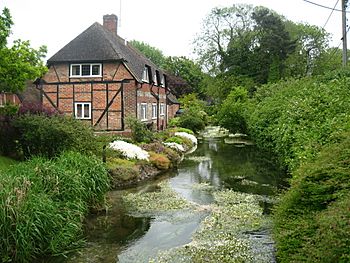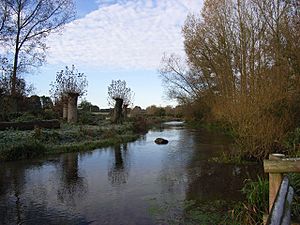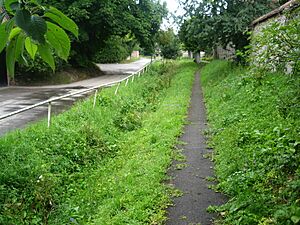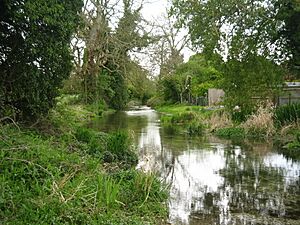River Lambourn facts for kids
Quick facts for kids River Lambourn |
|
|---|---|

River Lambourn, East Garston, Berkshire
|
|
| Country | England |
| Counties | Berkshire |
| Towns | Lambourn, Great Shefford, Welford, Newbury |
| Physical characteristics | |
| Main source | Lambourn, Berkshire, United Kingdom 130 m (430 ft) 51°30′58″N 1°32′15″W / 51.51606°N 1.53750°W |
| River mouth | River Kennet Newbury, Berkshire, United Kingdom 70 m (230 ft) 51°24′08″N 1°17′48″W / 51.40236°N 1.2968°W |
| Site of Special Scientific Interest | |
 |
|
| Area of Search | Berkshire |
|---|---|
| Interest | Biological |
| Area | 28.9 hectares (71 acres) |
| Notification | 1995 |
| Location map | Magic Map |
The River Lambourn is a special kind of river called a chalk stream in the English county of Berkshire. It starts in the Berkshire Downs near the village of Lambourn. The River Lambourn flows into the River Kennet, which then flows into the famous River Thames.
This river is very important for nature. It is a biological Site of Special Scientific Interest (SSSI), which means it's a protected area because of its unique plants and animals. It's also a Special Protection Area for birds, showing how vital it is for different bird species.
Contents
The River's Journey
The River Lambourn doesn't always flow in its upper parts. These sections are seasonal, meaning they can dry up sometimes. The river's main source comes from springs located upstream of Great Shefford village. When there's a lot of water underground, usually from November to March, the river starts flowing further upstream.
Along the seasonal part of the river, you'll find villages like Eastbury and East Garston. Further down, where the river flows all year, are villages such as Great Shefford, Welford, Boxford, Bagnor, Donnington, and Shaw. The River Lambourn joins the River Kennet between Newbury and Thatcham. The Lambourn has one small river that flows into it all year, called the Winterbourne Stream, which joins it at Bagnor.
Starting Point: Upper Lambourn
The highest point where the River Lambourn begins is in the village of Upper Lambourn. It often starts as water coming out of a drain. Sometimes, it flows in a small channel next to the road. In the village, it goes underground in a pipe before reappearing.
At first, it's just a small, muddy ditch. But as it goes through Lynch Wood, it gets bigger. Several springs feed the river here, making it wider and deeper. Even though parts of the river can dry up, the section below Lynch Wood usually keeps flowing. However, it did dry up in 2009 and again from 2010 to 2012. When it fills up, the nearby roads can sometimes flood.
Through Villages to Newbury
The river leaves Lynch Wood and flows under a bridge into Lambourn. Here, it flows faster as the channel becomes narrower. Houses are built close to the riverbanks. In July 2007, some houses were flooded because weeds blocked the river under small bridges.
The river passes by The Lamb pub and the Fire and Rescue Service. It flows between houses and playing fields. There's a ford (a shallow place to cross) near Bockhampton Road bridge, which horses use. The river then leaves the town through Bockhampton Manor Farm.
Further on, at Bernard's Ford near Eastbury, only tractors and horses can cross. In July 2007, the river overflowed here and flowed down Newbury Road before rejoining its path. The Lambourn runs right through Eastbury. The Plough Inn in Eastbury even holds a fun "Great Eastbury Duck Race" on the river in May!
In East Garston, many houses have their own bridges over the river to reach the road. The river splits into several channels at Great Shefford and is joined by many small streams. From Lambourn to Newbury, the river generally runs alongside the Newbury Road, crossing it many times. In Newbury, it flows between Donnington and Speen, and south of Shaw House. Finally, it joins the River Kennet near The Nature Discovery Centre. The River Kennet then flows into the River Thames at Reading.
The River's Natural Flow
The River Lambourn is special because its natural flow hasn't been changed much by people taking water from underground. This is quite rare for a chalk stream in southern England.
In the 1960s, there was a plan to use water stored deep underground in the chalk rock to supply London during dry times. The idea was to pump this water into rivers like the Lambourn, which would then carry it to the River Kennet and the River Thames, and finally to London.
A test project, called the Lambourn Valley Pilot Scheme, ran from 1967 to 1970. It showed that the idea might work. So, many large wells and pipes were built in the Lambourn area and other nearby river areas. This big project, called the Thames Groundwater Scheme, was finished in 1976. However, when they tested it, they found that it didn't really increase the river flow much. So, the project was not very successful.
Most of the equipment from this project is still there and looked after. But the most important thing is that because of this project, the River Lambourn's underground water system has been kept almost completely natural. This made it a perfect place for scientists to study how water moves through chalky ground.
A Historic Battleground
In 1644, during the English Civil War, King Charles I's army set up defenses where the River Lambourn meets the River Kennet. They built strong points at Shaw House and Speen. On October 27, 1644, the Parliamentarian armies attacked them here in the Second battle of Newbury.



